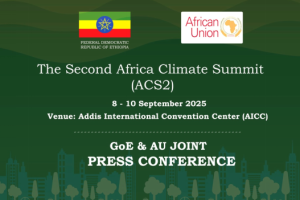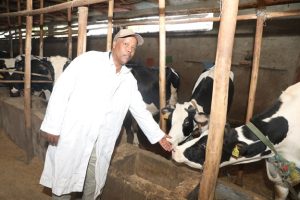
BY DARGIE KAHSAY
The world promised to fund 100 billion USD to support the climate action efforts of developing countries and as a reward for developing countries from the high carbon emission industrialized countries. But, the pledged fund remained a paper tiger, a mere promise which practically is unseen since it depends on the commitment and goodwill of the developed world.
Since the agreement lacks enforcement mechanism to mobilize the promised and agreed fund, the developing world is suffering from the climate change and their climate actions activities are dependent to their limited economic capacity.
The developing countries, striving to fulfill the basic needs of their citizens even during a normal situation, the outbreak of the COVID-19 and currently the Russia-Ukraine War exacerbates the economic situations of these countries. These developments in the world are badly affecting the development initiatives and economic activities of the developing and poor countries.
On top of this, climate change is worsening from time to time and affecting the economy, development efforts and adding new catastrophes for the developing world countries and citizens. The floods, droughts, Desert Locust swarms, shortage of rainfall and other natural disasters due to climate change are consuming economies and lives in the developing world.
Carrying all these natural and man-made multidimensional challenges and problems, developing countries are struggling both to fulfill the basic needs of their citizens as well as investing in natural protection by reducing some of the budgets from the basic needs they can provide to their citizens. By doing so, the natural protection and conservation efforts in the developing countries at the expense of their internal economic development are saving the world from further climate related impacts.
Though the countries of the developing world are fighting against climate changes at the expense of their economic developments, the climate actions and green investments in the developing world is constrained by dire economic situations. Especially, the recent developments in the world are exacerbating both the economic situations and the climate actions in the developing world. Parallel to these global developments, the developing world countries are on high crisis in paying their debts. The debtors are from the developed world and mostly those expected to fund the 100 billion climate finance sources.
With all these challenges that the developing world countries are facing in addition to their limited economic capacities, the world is expecting more actions in the climate sector including in reducing carbon emissions, protecting natural forests and investing in green energy sources without providing sufficient supports. Even the developed world never considers the debt payment mechanisms for the developing world. Hence, debt payment during this time is an additional headache for the developing countries and surely affecting their climate actions.
Taking in to account all these natural and manmade global developments and the necessity of investing on climate action, what is the world considers debt swap as one mechanism of climate financing in the developing world instead of promising unpractical funds in the climate sector?
Ethiopia is not an exception in facing all these crises and challenges, but remains an exception in applying greenery actions even during this difficult period. Though, the global developments including the impacts of climate change are affecting its economic development efforts including a severe drought that hits the Horn of African countries, parallel to striving to provide necessary basic needs for its citizens, the country gives due attention for climate action, both mitigation and adaptation measures.
Similar to other developing countries in addition to the above challenges, Ethiopia is facing serious challenges from heavy debt that the country borrowed from the developed world to facilitate its economic development endeavors. Following the outbreak of the COVID-19 that forced for world-wide economic shrinks, the developing countries’ economies are badly affected. The economic impacts of COID-19 was severe in emerging economies and while these countries are striving to provide basic needs for their citizens affected by the impacts of the COVID-19, debt payment remains an additional challenge. Ethiopia is among these countries facing the multidimensional challenges.
But, Ethiopia’s climate action efforts even during this challenging time remain exceptionally exemplary. Ethiopia successfully completed its four years Green Legacy initiative by planting over 25 billion seedlings. Ethiopia’s Green Legacy initiative launched in 2019 with the goal of planting four billion seedlings within four years period exceeds its plan by planting 25 billion trees. Only this season, in 2022 rainy season, Ethiopia planted over seven billion seedlings. To prepare and plant over 35 billion seedlings, Ethiopia invests billions of dollars in addition to mobilizing tens of millions of citizens.
Recently, Agriculture Minister Umer Hussen said that, Ethiopia increased nursery stations for seedling preparation from 27 thousand in 2019 to 130 thousand in 2022. This consumes huge budget and human resource. Green Legacy initiative of Ethiopia is one among its multidimensional climate actions and investments. Ethiopia achieved this huge target struggling with multidimensional challenges and crisis. Without a national spirit and government’s commitment, this achievement is unthinkable during this difficult time. Ethiopia’s Green Legacy initiative is launched to achieve Ethiopia’s plan of increasing its forest coverage to 30 percent which stands around 17 percent currently, to meet global standard.
Ethiopia’s Green Legacy initiative is not an exceptional climate action of Ethiopia. Ethiopia is investing in expanding green energy development to produce green energy from renewable energy sources, hydro, solar, wind and geothermal sources. Ethiopia is investing tens of billions of dollars in green energy production including constructing the biggest dam in Africa which started its early production this year, the Grand Ethiopian Renaissance Dam (GERD) and other huge national projects.
But, the world refused even providing loans for these projects mainly for the GERD, which have the capacity of transforming Ethiopia’s access to clean energy and achieve the target goals of the 2030s Sustainable Development Goals of Ethiopia. Still, with its limited economic capacity, Ethiopia is struggling to achieve these green projects in the energy sector.
At additional costs, the country’s economic development gives due attention to building green economy in its development endeavors. Ethiopia invests in expanding industrial parks and its industrial parks gives due attention for environmental protection. With limited economy, the additional investments to build environmental friendly economic development are incurring extra expenses against the country.
As part of its commitment to minimize carbon emission in the transport sector, Ethiopia is introducing electric vehicles, which shows Ethiopia’s multidimensional efforts in all sectors to build climate friendly national economy.
These investments in climate action are consuming huge national economy though the benefit is worldwide. Though the developed world has responsibility to fund and support such climate action initiatives and efforts in the developing world, not only remain silent in funding these initiatives but also remain a challenge by forcing the developing countries to pay debts during this difficult time.
Putting pressure on developing countries to pay debts during this difficult time is like a punishment for the developing countries, though they deserve rewards and additional funds. Hence, to promote the climate action efforts of developing nations, the developed world should consider debt swap as one mechanism of climate financing. Instead of shouting on unpractical climate funds and finances, debt cancelation and debt swap for countries actively engaged in nature and environmental protection should become as one mechanism of climate financing.
The Ethiopian Herald August 16/2022




